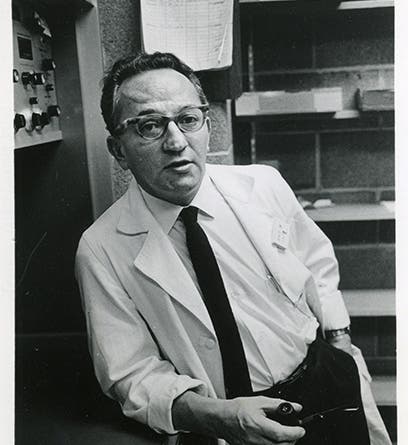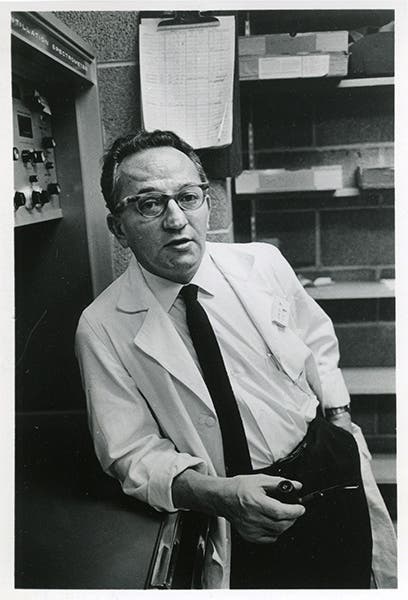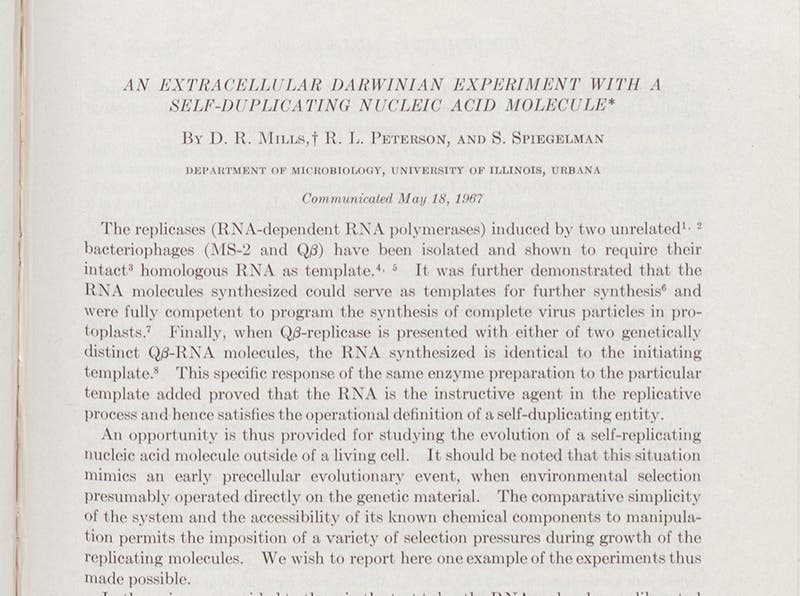Scientist of the Day - Sol Spiegelman
Sol Spiegelman, an American molecular biologist, was born Dec. 14, 1914. Heading up a lab at the University of Illinois in Urbana, Spiegelman in 1961 was studying bacteriophages, phages for short, which are viruses that invade bacteria, which obligingly then reproduce the virus. Most phages have DNA as their reproductive template, but Spiegelman and his team found one phage, called MS-2, that had no DNA at all. Instead, its genetic makeup was written in RNA, a single-stranded nucleic acid molecule that cannot self-replicate, as DNA can. RNA was not well understood in 1961 – its role as an intermediary between DNA and protein synthesis would only be discovered that same year. Spiegelman found that the reproduction of phage RNA was made possible by an enzyme, a polymerase, or RNA replicase, that would latch on to an RNA molecule and copy it.
The first RNA replicases studied were non-specific, that is, they would copy any RNA molecule they bumped into. Then Spiegelman found a phage called Q-beta, whose RNA replicase was very specific. It would copy the Q-beta RNA, and no other. Put it in a sea of RNA molecules, and only the Q-beta would be reproduced. In 1965, Spiegelman's group did a now-famous experiment. Starting out with Q-beta RNA from a Q-beta phage, they put it in a solution with Q-beta RNA replicase, and various bases and salts, and the replicase began copying the Q-beta RNA, even though it was not in a living environment. Spiegelman then removed the manufactured RNA, transferred it to a fresh solution, and continued the process, and then transferred it again, and again, so that by the final transfer, any original RNA from the phage was long gone, and the only RNA remaining was that which had been manufactured in the artificial environment. And when this RNA was returned to a living phage, it did everything the original RNA could do, even though it had been artificially produced.
The results were announced with great fanfare – this was a newsworthy event, and Spiegelman was lauded in the press for having created life in a test tube, which of course he had not done, and which he denied over and over – copying a molecule taken from a living virus is not the same thing as making life from scratch. Still, this was the first time that RNA had been removed from a virus or cell, replicated, and then re-inserted in full working order. The artificial RNA molecule was dubbed Spiegelman's monster, in homage to Frankenstein's monster, artificial life on a larger scale.
The experiment Spiegelman did next was even more exciting, if you were a Darwinian evolutionist. Spiegelman decided to make his Q-beta monsters compete for resources. He thought that since the molecule no longer had to carry instructions for many of the phage's activities, it could dispense with a large amount of its RNA. Its only requirement for survival was that the replicase recognize it and replicate it. And what Spiegelman hoped for came to pass. Some of the RNA molecules became shorter. That meant that they were replicated more rapidly, and so before long there were more of them. As the molecules were moved from solution to solution, they got more and more truncated, every reduction in size giving the molecule an advantage in its speed of replication. By the 74th transfer, Spiegelman was seeing RNA molecules that were only 17% - one-sixth - of the size of the original. The molecule had gone from 4200 bases in length to about 700. It had evolved in its artificial environment, under the pressure of natural selection.
Spiegelman announced the results in a paper with the instructive title: "An extracellular Darwinian experiment with a self-duplicating nucleic acid molecule," published in the Proceedings of the National Academy of Sciences in 1967. I pulled it off the shelf to show you the first page (second image), and the concluding summary (third image). Spiegelman thought that his experiments demonstrated that natural selection was in operation long before there were any cells on Earth at all, and that nucleic acid molecules developed their complexity as a result of this selective pressure.
Spiegelman moved to Columbia University in 1969, after 20 years at Illinois, and he worked there until his death from cancer in 1983, at age 68.
William B. Ashworth, Jr., Consultant for the History of Science, Linda Hall Library and Associate Professor emeritus, Department of History, University of Missouri-Kansas City. Comments or corrections are welcome; please direct to ashworthw@umkc.edu.









